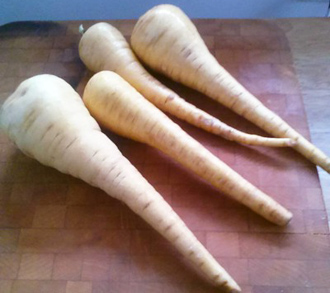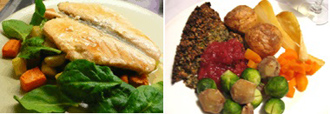Parsnips Nutrition facts
Parsnips, closely akin to the carrot family, are succulent underground taproots. They share akin appearances and growing traits with other members of the Apiaceae family such as carrots, parsley, celery, cumin, and dill.Botanically classified under the Umbelliferae (Apiaceae) family, they belong to the genus Pastinaca.
Scientific name: Pastinaca sativa.
 |
| Parsnips. Notice ivory colored taproots. Courtesy: Amy Ross |
Pastinaca sativa is a biennial, cool-season crop native to the Mediterranean region. In its first year, it grows to about 1-1.5 meters in height and bears underground taproots, which are generally harvested after the first frost of the season. If left alone, the plant develops small yellow flowers in clusters, followed by seed pods in the next season.
Its fleshy, stout roots appear as those of carrots but are white or cream-colored and sweeter in taste than carrots. Adequate winter frost is crucial for a successful yield. Frost facilitates the conversion of starch into sugars and contributes to the development of long, narrow, and firm roots.
Harvesting of the roots usually occurs when they reach a length of six to ten inches by uprooting the entire plant similar to carrots.
7 Amazing Health Benefits of Parsnips
Parsnips contain higher levels of sugar compared to carrots, radishes, and turnips. With 75 calories per 100 grams, parsnips provide a similar calorie count to certain fruits like bananas and grapes. Despite this, their sweet and juicy roots contain no cholesterol and are packed with various health-promoting phytonutrients, vitamins, minerals, and fiber.
Parsnips are exceptional sources of both soluble and insoluble dietary fiber. A 100-gram serving of parsnip root offers 4.9 mg or 13% of the recommended fiber intake. Sufficient fiber consumption aids in lowering blood cholesterol levels and helps prevent obesity and constipation.
Similar to carrots and other vegetables within the Apiaceae family, parsnips contain numerous poly-acetylene antioxidants such as falcarinol, falcarinol, panaxydiol, and methyl-falcarindiol.
Research conducted by scientists at the University of Newcastle, Tyne has revealed that these compounds possess anti-inflammatory, antifungal, and anti-cancer properties, offering protection against colon cancer and acute lymphoblastic leukemia (ALL).
Fresh parsnip roots are rich in vitamin C, providing approximately 17 mg or 28% of the recommended daily allowance (RDA). Vitamin C, a potent water-soluble antioxidant found abundantly in natural sources, supports the maintenance of healthy connective tissue, teeth, and gums. Its antioxidant properties aid in protecting against diseases and cancers by neutralizing harmful free radicals within the body.
Parsnip roots also boast high levels of various B-complex vitamins such as folic acid, vitamin B-6 (pyridoxine), thiamin, and pantothenic acid, alongside vitamin K and vitamin E.
Furthermore, parsnips contain significant levels of essential minerals including iron, calcium, copper, potassium, manganese, and phosphorus. Potassium, a crucial electrolyte, plays a vital role in regulating heart rate and blood pressure by counteracting the effects of sodium.
| Principle | Nutrient Value | Percent of RDA |
|---|---|---|
| Energy | 75 Kcal | 4% |
| Carbohydrates | 17.99 g | 14% |
| Protein | 1.20 g | 2% |
| Total Fat | 0.30 g | 1% |
| Cholesterol | 0 mg | 0% |
| Dietary Fiber | 4.9 g | 13% |
| Vitamins | ||
| Folates | 67 µg | 17% |
| Niacin | 0.700 mg | 4% |
| Pantothenic acid | 0.600 mg | 12% |
| Pyridoxine | 0.90 mg | 7% |
| Riboflavin | 0.050 mg | 4% |
| Thiamin | 0.090 mg | 7.5% |
| Vitamin A | 0 IU | 0% |
| Vitamin C | 17 mg | 29% |
| Vitamin K | 22.5 µg | 19% |
| Electrolytes | ||
| Sodium | 10 mg | <1% |
| Potassium | 375 mg | 8% |
| Minerals | ||
| Calcium | 36 mg | 3.5% |
| Copper | 0.120 mg | 13% |
| Iron | 0.59 mg | 7.5% |
| Magnesium | 29 mg | 7% |
| Manganese | 0.560 mg | 24% |
| Phosphorus | 71 mg | 10% |
| Selenium | 1.8 µg | 3% |
| Zinc | 0.59 mg | 5% |
| Phyto-nutrients | ||
| Carotene-α | 0 µg | -- |
| Carotene-ß | 0 µg | -- |
| Crypto-xanthin-ß | 0 µg | -- |
| Lutein-zeaxanthin | 0 µg | -- |
Selection and storage
In Northern Europe, the parsnip season kicks off shortly after the first frost and extends until March, inundating markets with fresh produce. Many families take advantage of this season by cultivating parsnips and carrots in their home gardens.
When selecting parsnips at the markets, opt for ones that are fresh, firm, fleshy, and of medium size, with smooth surfaces. Avoid elongated, thin, or tail-like roots as they tend to be fibrous and less desirable for cooking. Additionally, steer clear of woody, overly mature parsnips, as they can have an unpleasant taste. Avoid purchasing parsnips that are soft, shriveled, pitted, knobby, or damaged.
For storage, place parsnips in a plastic bag and store them in the vegetable drawer of the refrigerator, maintaining a temperature between 0°C and 5°C. Avoid freezing raw parsnips.
Preparation and serving methods
 |
| Salmon with roasted sweet potatoes and parsnips cubes. ( Photo courtesy: plindberg) and Stirfried parsnips with carrot, brussel sprouts, and potato. (Photo: janetmck) |
To prepare, wash them in cold water and scrub or gently peel its skin. Trim off the ends, then slice them into cubes, discs, or any other desired shapes.
Cook parsnips similarly to carrots, being careful not to overcook. They soften rapidly due to their higher sugar content compared to starch.
Here are some serving tips:
Raw parsnips lend a distinct sweet flavor to salads, coleslaw, and toppings.
They can be cooked and mashed with potato, leeks, cauliflower, and more.
Sliced or cubed, they enhance stews, soups, and stir-fries, and pair well with poultry, fish, and meat.
They are versatile additions to bread, pies, casseroles, cakes, and various savory dishes.
Safety profile
in some sensitive people, handling parsnip plants and their parts can lead to hypersensitivity reactions such as contact dermatitis and oral allergy syndrome (OAS).
Symptoms of these reactions may manifest as rash and skin lesions. Common OAS symptoms include itching or a burning sensation in the lips, mouth, and throat. In severe cases, individuals may experience swelling of the lips and tongue, redness in the eyes, and difficulty breathing. Those with a known allergy history to birch category pollen agents such as walnuts, figs, carrots, parsley, etc., may also develop cross-sensitivity to parsnip and should avoid contact. (Medical disclaimer).
≻≻-Back to Vegetables from Parsnips. Visit here for an impressive list of vegetables with complete illustrations of their nutrition facts and health benefits.
≻≻-Back to Home page.
Further reading:
Refer Stanford School of Medicine Cancer information Page- Nutrition to Reduce Cancer Risk.